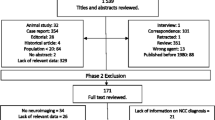Abstract
Objective
To ascertain the prevalence of active epilepsy, febrile seizures (FS), cerebral palsy (CP) and tic disorders (TD) in aged 19 years or less.
Methods
This was a cross-sectional observational study conducted as a two-stage door-to-door survey of a stratified randomly selected population in 2003-04. Trained field workers screened the population followed by case examination by the field neurologist.
Results
A total of 16979 (male 8898, female 8081) subjects aged ≤ 19 years were surveyed. The prevalence rates per 100,000 population of active epilepsy, FS, CP and TD with 95% confidence intervals are 700.87 (580.60–838.68), 1113.14 (960.07–1283.59), 282.70 (CI 208.43–374.82) and 35.34 (12.96–76.92) respectively. Active epilepsy prevalence shows a rising trend and that of other disorders a declining trend with age. Of the epileptics who had brain CT scans, 23.4% showed single or multiple lesions suggestive of neurocysticercosis. Regarding treatment, 23.5% of the epileptics never received any antiepileptic drugs. Among those with history of FS, 9.5% developed epilepsy later on. The prevalence of FS among slum dwellers is lower than in the non-slum population. Among CP cases, 39.6% gave history of birth anoxia, 16.7% kernicterus and 31.3% epilepsy. Prevalence of CP is significantly associated with lower education status.
Conclusion
The prevalence of CP and TD is lower than reported from western countries. CP prevalence is also comparatively lower than in many community studies from India. Compared to western nations, higher proportion of FS cases develops epilepsy. A third of the CP cases have seizures which is higher than in many Indian studies. Birth anoxia is a common cause of CP and educational underachievement is frequent.
Similar content being viewed by others
References
Ahmad OB, Boschi-Pinto C, Lopez AD, Murray CJL, Lozano R, Inoue M. Age standardization of rates: a new WHO standard [GPE Discussion Paper Series No. 31]. Geneva: World Health Organization; 2000.
Sridharan R, Murthy BN. Prevalence and pattern of epilepsy in India. Epilepsia 1999; 40: 631–636.
Mani KS, Rangan G. The Yelandur model for rural epilepsy control in India. In Singhal BS, Nag D, eds. Epilepsy in India Xxxxx: Indian Epilepsy Association; 2000; 16–31.
Das SK, Sanyal K. Neuroepidemiology of major neurological disorders in rural Bengal. Neurol India 1996; 44: 47–58.
Razdan S, Kaul RL, Motta A, Kaul S, Bhatt RK. Prevalence and pattern of major neurological disorders in rural Kashmir (India) in 1986. Neuroepidemiology 1994; 13: 113–119.
Gourie-Devi M, Gururaj G, Satishchandra P. Neuroepidemiology in developing countries: a manual for descriptive studies. Bangalore; Prism Publishers, 1997.
Radhakrishnan K, Nayak SD, Kumar SP, Sarma PS. Profile of antiepileptic pharmacotherapy in a tertiary referral center in South India: a pharmacoepidemiologic and pharmacoeconomic study. Epilepsia 1999; 40: 179–185.
de Bittencourt PR, Adamolekum B, Bharucha N, Carpio A, Cossío OH, Danesi MA et al. Epilepsy in the tropics II: clinical presentations, pathophysiology, immunologic diagnosis, economics, and therapy. Epilepsia 1996; 37: 1128–1137.
Das SK, Biswas A, Roy T, Banerjee TK, Mukherjee CS, Raut DK, Chaudhuri A. A random sample survey for prevalence of major neurological disorders in Kolkata. Indian J Med Res 2006; 124: 163–172.
International League Against Epilepsy. The epidemiology of the epilepsies: future directions [ILAE Commission Report]. Epilepsia 1997; 38: 614–618.
Waruiru C, Appleton R. Febrile seizures: an update. Arch Dis Child 2004; 89: 751–756.
Berg AT, Shinnar S. Complex febrile seizures. Epilepsia 1996; 37: 126–133.
Mutch L, Alberman E, Hagberg B, Kodama K, Perat MV. Cerebral palsy epidemiology: where are we now and where are we going? Dev Med Child Neurol 1992; 34: 547–551.
Marcus D, Kurlan R. Tics and its disorders. Neurol Clin 2001; 19: 735–758.
Radhakrishnan K, Pandian JD, Santhoshkumar T, Thomas SV, Deetha TD, Sarma PS et al. Prevalence, knowledge, attitude, and practice of epilepsy in Kerala, South India. Epilepsia 2000;41: 1027–1035.
Mani KS. Epidemiology of epilepsy. In Wadia NH, ed. Neurological practice: an Indian perspective. New Delhi; Elsevier, 1997; 267–284.
Rajshekhar V, Raghava MV, Prabhakaran V, Oommen A, Muliyil J. Active epilepsy as an index of burden of neurocysticercosis in Vellore district, India. Neurology 2006;67: 2135–2139.
Udani V. Pediatric epilepsy — an Indian perspective. Indian J Pediatr 2005; 72: 309–313.
Nelson KB, Ellenberg JH. Prognosis of children in febrile seizures. Pediatrics 1978; 61: 720–727.
Ross EM, Peckham CS, West PB, Butler NR. Epilepsy in childhood: findings from the National Child Development Study. Br Med J 1980; 280: 207–210.
Joint Working Group of the Research Unit of the Royal College of Physicians and the British Paediatric Association. Guidelines for the management of convulsions with fever. Br Med J 1991; 303: 634–636.
Verity CM, Butler NR, Golding J. Febrile convulsions in a national cohort followed up from birth. II- Medical history and intellectual ability at 5 years of age. Br Med J 1985; 290:1311–135.
Brett EM. Cerebral palsy, perinatal injury to the spinal cord and brachial plexus birth injury. In Brett EM, ed. Pediatric Neurology. 2nd ed. Edinburgh; Churchill Livingstone, 1996; 285–316.
Srivastava VK, Laisram N, Srivastava RK. Cerebral palsy. Indian Pediatr 1992; 29: 993–996.
Singhi PD, Ray M, Suri G. Clinical spectrum of cerebral palsy in north India — an analysis of 1,000 cases. J Trop Pediatr 2002;48: 162–166.
Kudrjavcev T, Schoenberg BS, Kurland LT, Groover RV. Cerebral palsy: survival rates, associated handicaps, and distribution by clinical subtype (Rochester, MN, 1950–1976). Neurology 1985; 35: 900–903.
Author information
Authors and Affiliations
Corresponding author
Rights and permissions
About this article
Cite this article
Banerjee, T.K., Hazra, A., Biswas, A. et al. Neurological disorders in children and adolescents. Indian J Pediatr 76, 139–146 (2009). https://doi.org/10.1007/s12098-008-0226-z
Received:
Accepted:
Published:
Issue Date:
DOI: https://doi.org/10.1007/s12098-008-0226-z




